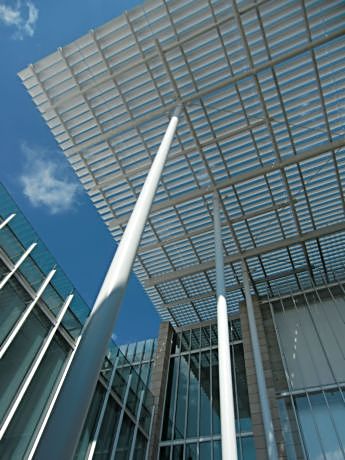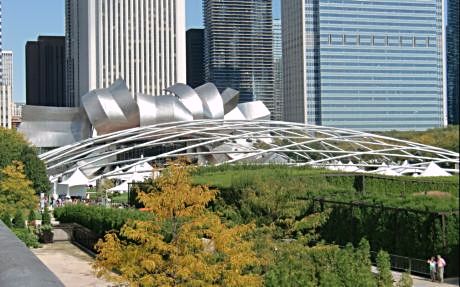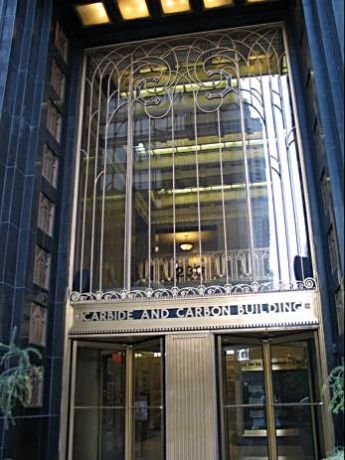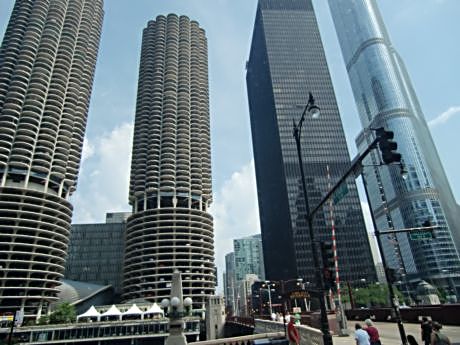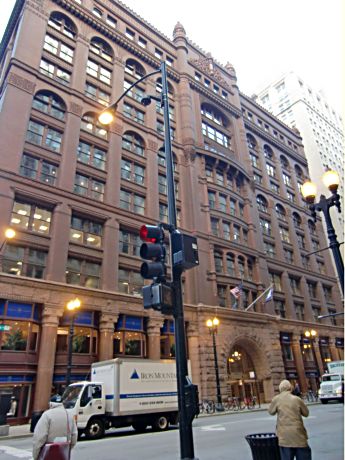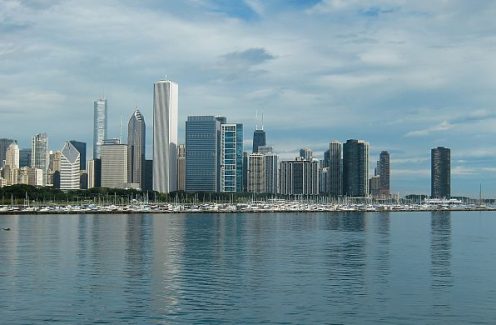
Known for years as Carl Sandburg’s “City of the Big Shoulders” for its stock yards and freight crossroads, Chicago has metamorphosed into a foodie and festival city. It’s also a cultural arts city, an architecture city and shopping city. Indeed, there’s enough to do here to fill a week but when all you have is three days it’s helpful to have a plan. Just remember to figure in downtime even if your walking shoes are comfy.
BTW, if you want to link your visit to one of the city’s famed free festivals in Millennium Park, Grant Park or along Lake Michigan, you might want to check these 2019 dates. The Chicago Blues Festival is June 7-9 in Millenium Park. Taste of Chicago is July 10-14 in Grant Park. Chicago Air and Water Show is Aug. 17-18 at North Avenue Beach north of the downtown and the Chicago Jazz Festival is Aug 31-Sept. in Millennium Park, the Chicago Cultural Center and other venues.
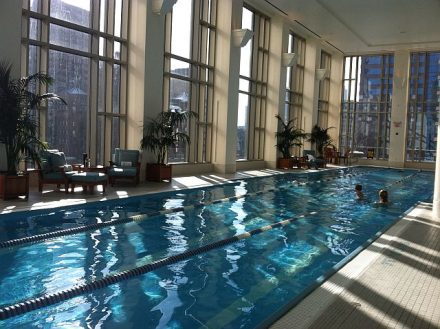
First Day
Consider splurging and booking into the Chicago Peninsula Hotel at 108 E. Superior St.
The rooms and service plus the wellness area’s pool and spa make a stay here really feel like a vacation. And that is before you realize how close you are to good shopping, good food, good museums and good theater.
When you walk out the hotel door you turn the corner onto North Michigan Avenue’s Magnificent Mile. Walking either way, north to Oak Street or south to the Chicago River, you will find Cartier, Lester Lampert, Rolex, Swarovsk,Tiffany & Co. and David Yurman, plus Burberry, Bottega Veneta, Bulgari, Chanel, La Perla, Louis Vuitton, Ralph Lauren, Salvatore Ferragamo and Giorgio Armani.
And that doesn’t even count Bloomingdale’s, Macy’s Neiman Marcus, Nordstrom and Saks Fifth Avenue or the indoor upscale malls of 900 North Michigan Shops that include Gucci, Lululemon Athletica Michael Kors or Water Tower Place (835 N. Michigan) which has the American Girl Place, Candyality, Clark Shoes and Coach or The Shops at North Bridge (520 N. Michigan) with BOSS Hugo Boss, Armani Exchange, Ermenegildo Zegna, Louis Vuitton, Stuart Weitzman and Vosges Haut-Chocolat.
But before heading out you may want to see if you can get tickets to the Ham Exhibition. That’s the immersive, 360 degree, interactive, multi-room exhibit that tells more and shows more about the “Hamilton” musical’s featured characters, their history and background than you find in the show. The exhibition is in a temporary building on Northerly Island on a strip of land just south of the Adler Planetarium. It’s up now through sometime this fall (rumored to leave sometime in September).
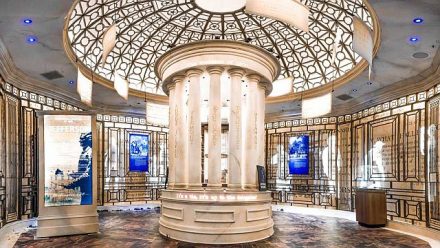
Also think about what else you want to see that needs tickets.
Chicago is rich in theater options. There are about 250 theater companies in the Chicago area but if you want to stay in your theater-area you might want to get tickets downtown to a Broadway in Chicago musical or a show at award-winning Goodman Theatre or at Lookingglass Theatre in the Chicago Water Works building.
Also check with the Chicago Architecture Center to find out what tours are available while you are in town. A really popular one is the boat tour on the Chicago River but the others are also good and interesting, including a walking tour of the city’s art deco buildings.
Now, have fun shopping. The malls mentioned have places to eat lunch but if you are at Water Tower Place check the many choices on the Mezzanine.
Whew! All that planning and shopping the Mag Mile deserve a time-out swim in the Peninsula Pool or a spa visit before thinking about dinner.
The hotel’s cuisine is excellent but if you want to do cocktails and then go out consider the hotel’s Z Bar for its views, music (and food) or go over to the Fig & Olive on Oak Street for cocktails and their crostini appetizers.
For dinner, if you didn’t stay at the Z Bar or Fig & Olive, but are interested in upscale Italian/Mediterranean cuisine, snag a reservation at Spiaggia. Chef-Partner Tony Mantuano’s multi-award winning restaurant at the corner of Oak Street and North Michigan Avenue.
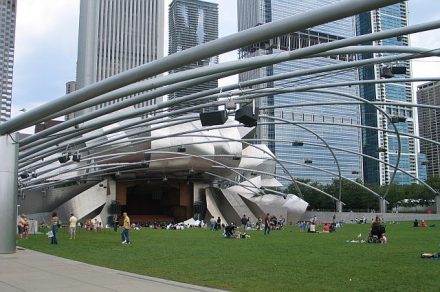
Second Day
Breakfast. Just outside the hotel door and to the left at the corner is the Peninsula’s French café, Pierre Gourmet. You may think you are going there just for really excellent croissants and coffee but you are likely to order more after seeing the menu and deciding to take something back to your room. The café is a favorite neighborhood place to stop for breakfast, lunch and mid-day breaks.
Depending on if or when you have tickets for the Ham Exhibition or a Chicago Architecture Center tour, make Day Two a Millennium Park/Museum Day.
No matter which tour you take or exhibit you see, spend time at Millennium Park on Michigan Avenue between Randolph and Monroe Streets. You can walk or take almost any bus from around the corner of the Peninsula Hotel south on Michigan Avenue to Randolph or Madison Street.
That overblown steel ribbon you’ll see in the park is the top of the Frank Gehry designed Pritzker Pavilion.
If you are an early riser and didn’t run along Lake Michigan this morning before breakfast, consider joining a workout in Millennium Park on the Great Lawn by the Pritzzger Pavillion.
Then do breakfast across Randolph and Michigan at Free Rein next to the Saint Jane Hotel.
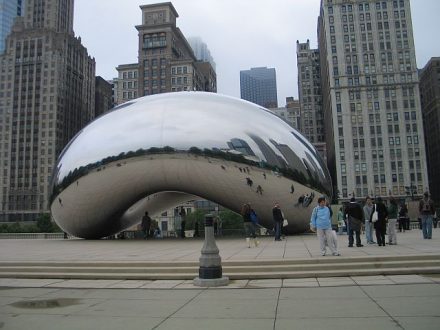
But go back to Millennium Park, home of Chicago’s famed “Bean.” Actually called “Cloud Gate” by its British sculptor Anish Kapoor, the Bean is where tourists and residents alike do selfies, take each others pictures, snap photos of the skyline relected on its 110-ton elliptical shape and walk through its concave arch.
Don’t leave without seeing the Crown Fountain whose giant faces “spit” water into a zero-depth wading/reflecting pool . Designed by Spanish artist Jaume Plensa, the fountain consists of two, 50-foot glass block towers with changing faces of real Chicago residents.
You might have noticed that the Art Institute of Chicago is across Millennium Park’s Monroe Street side. The museum’s blockbuster summer show running only to Sept. 8, 2010, is the gorgeous “Manet and Modern Beauty.” Purchase tickets to the museum and the show ($7 extra) when you visit.
To see a part of the museum that won’t cost anything, walk up the Nichols Bridgeway that starts in Millennium Park and reaches an upper level of the Art Institute of Chicago’s Modern Wing. Go inside and then back outside but on the The Bluhm Family Terrace.
Here’s a great place to take in the skyline and see Millennium Park from above. The Terrace also features temporary modern sculptures. To leave, take an elevator or escalators down to Griffin Court in the Modern Wing.
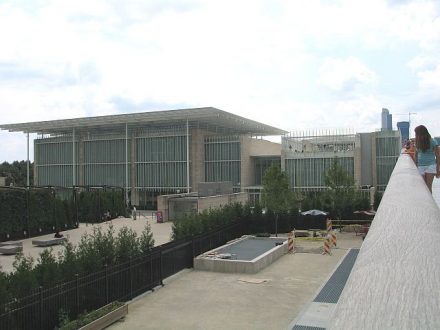
If at the museum near lunch time try to reserve a table at the back of the Terrace at Terzo Piano. The food by Spiiaggia’s Tony Mantuano, and the view, part of Modern Wing architect’s Renzo Piano’s plan, are terrific.
Another good Millennium Park neighborhood eating choice is Park Grill below the Bean in Millennium Park near the Crown Fountain.
You can easily spend a day at the Art Institute of Chicago but even if you have just an hour or two pick up a gallery map or the Art Institute’s app to see “A Sunday Afternoon on the Island of La Grande Jatte by Georges Seurat, “Water Lilies” by Claude Monet, the “America Windows by Marc Chagall and “Woman Descending the Saircase” by Gerhard Richter.
However, here is another tip: Go downstairs the main part of the museum to the Thorne Miniature Rooms to see 68 incredible doll-house-size replicas of European and American interiors including a cathedral.
Your day of surprises isn’t up yet. Cross Michigan Avenue to what is sometimes called “The People’s Palace.” It is the Chicago Cultural Center (formerly the main public library), home of good art exhibits, lectures and concerts but for your quick visit, home of spectacular mosaics and stained glass domes.
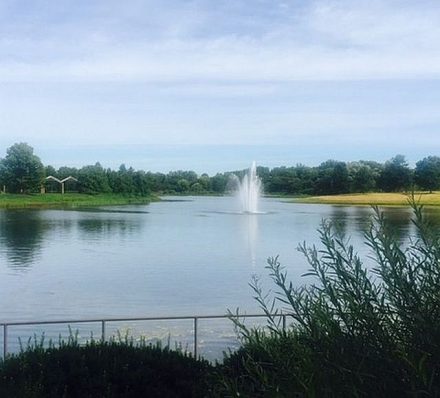
Third Day
Make it an outdoor botanic and music day in Chicago’s northern suburbs.
Dive or take a train on the Union Pacific North Line from the Ogilvie Transportation Center on Madison Street to the Braeside station in suburban Highland Park.
From Braeside, a Highland Park stations, cross Lake Cook Road to wander the path west through a Cook County Forest Preserve across Green Bay Road to the Chicago Botanic Garden, 1000 Lake Cook Road, Glencoe.
Or drive there from Chicago along Lake Michigan from Lake Shore Drive to Sheridan Road. You will pass Northwestern University in Evanston, the gorgeous Bah’ai Temple in Wilmette, through the winding ravines of Winnetka/Hubbard Woods, past North Shore Congregation Israel designed by Minoru Yamasaki to the stoplight at Lake Cook Road. Go west two more lights to the Botanic Garden. The garden is free (except the butterfly building), but there is a parking charge if you drove.
Owned by the owned by the Forest Preserve District of Cook County and operated by the Chicago Horticultural Society, you can view it by the numbers,: 27 gardens and four natural areas, 385 acres, nine islands and six miles of river-pond shoreline. Or just go and wander into its Butterfly and Blooms building which re-opend the end of May and goes through Sept. 2, 2019 on the north side of the Garden.
Then visit a wonderful Japanese Garden, fragrant Rose Garden, fun Model Railroad Garden, interesting greenhouses with different climates and the nearby Bonsai patio. Snap photos by the fountain in the lake and if there on a Saturday or Sunday check out the Chef series in the Regenstein Fruit and Vegetable Garden.
Stop for a bite at the Garden View Café where you can eat indoors or outside on a deck with a view.
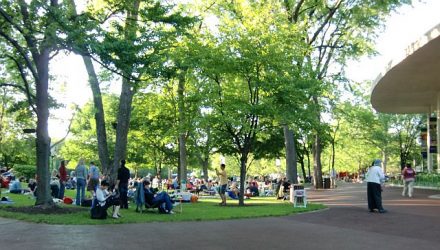
Plan to spend the evening at Ravinia Festival, a historic music venue that opened in 1904. Ravinia is the summer home of the Chicago Symphony Orchestra but also does pop concerts.
It is within walking distance of the garden if you took the train to Braeside. Walk back to the station, then follow a path or the street north along the tracks to the Ravinia Festival gate. There is a ticket charge to enter the grounds or sit in the Pavilion that varies according to the program. Classical is cheaper than pop. A train stops at the Ravinia Festival to return to Chicago’s Ogilvie station.
It almost doesn’t matter what is going on there when you’re in town because merely going is an experience.
Guests come from all over northern Illinois and adjoining states to picnic on the grass and listen to music under the stairs. You will see everything from elaborate setups of candelabra to small blankets and chairs. Ravinia rents chairs so don’t worry about sitting if you don’t get a Pavilion ticket
.
If you drove, get around the Ravinia Festival lot charge by going to the Highland Park stations of Braeside, Ravinia (not the festival one but a neighborhood station) or downtown Highland Park to take the free shuttle. You can buy food at Ravinia for a picnic or dine in one of its restaurants (reservations suggested).
You could spend Day Three in Chicago because there are world class museums on the museum campus and you could visit Navy Pier, a popular Chicago destination where you can take a boat ride or you could visit the Lincoln Park Zoo and eat at The Patio at Cafe Brauer.
But if visiting the Chicago area in the summer the Chicago Botanic Garden and Ravinia Festival should be on the must-do list.
Happy travels!

